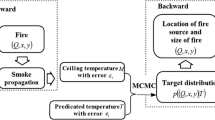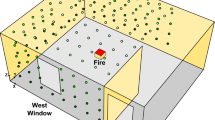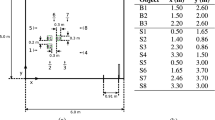Abstract
Fire models are routinely used to evaluate life safety aspects of building design projects and are being used more often in fire and arson investigations as well as reconstructions of firefighter line-of-duty deaths and injuries. A fire within a compartment effectively leaves behind a record of fire activity and history (i.e., fire signatures). Fire and arson investigators can utilize these fire signatures in the determination of cause and origin during fire reconstruction exercises. Researchers conducting fire experiments can utilize this record of fire activity to better understand the underlying physics. In all of these applications, the heat release rate and location of a fire are important parameters that govern the evolution of thermal conditions within a fire compartment. These input parameters can be a large source of uncertainty in fire models, especially in scenarios in which experimental data or detailed information on fire behavior are not available. A methodology is sought to estimate the amount of certainty (or degree of belief) in the input parameters for hypothesized scenarios. To address this issue, an inversion framework was applied to scenarios that have relevance in fire scene reconstructions. Rather than using point estimates of input parameters, a statistical inversion framework based on the Bayesian inference approach was used to calculate probability distributions of input parameters. These probability distributions contain uncertainty information about the input parameters and can be propagated through fire models to obtain uncertainty information about predicted quantities of interest. The Bayesian inference approach was applied to various fire problems using different models: empirical correlations, zone models, and computational fluid dynamics fire models. Example applications include the estimation of steady-state fire sizes in a compartment and the location of a fire.















Similar content being viewed by others
Notes
The examples in this paper were adapted from material provided during a PyMC tutorial session at the SciPy 2011 Conference [35]. The material is licensed under the GNU GPL v3.
The test report gives the height of the compartment as 2.18 m, which is a misprint. The compartment was 2.13 m high.
References
Redsicker DR, O’Connor JJ (1997) Practical fire and arson investigation, 2nd edn. CRC Press, Boca Raton
Kirk P, DeHaan J (1997) Kirk’s fire investigation. Brady, Upper Saddle River
Kruse C (2013) The Bayesian approach to forensic evidence: evaluating, communicating, and distributing responsibility. Soc Stud Sci 43(5):657–680
National Fire Protection Association (2011) Guide for fire and explosion investigations. NFPA 921, Quincy
Babrauskas V (2005) Charring rate of wood as a tool for fire investigations. Fire Saf J 40(6):528–554
Overholt KJ (2013) Forward and inverse modeling of fire physics towards fire scene reconstructions. Ph.D. dissertation, The University of Texas at Austin
Overholt KJ, Ezekoye OA (2012) Characterizing heat release rates using an inverse fire modeling technique. Fire Technol 48(4):893–909
Jahn W, Rein G, Torero JL (2012) Forecasting fire dynamics using inverse computational fluid dynamics and tangent linearisation. Adv Eng Softw 47(1):114–126
Cowlard A, Jahn W, Abecassis-Empis C, Rein G, Torero J (2010) Sensor assisted fire fighting. Fire Technol 46:719–741
Koo SH, Fraser-Mitchell J, Welch S (2010) Sensor-steered fire simulation. Fire Saf J 45(3):193
Lautenberger C, Rein G, Fernandez-Pello C (2006) The application of a genetic algorithm to estimate material properties for fire modeling from bench-scale fire test data. Fire Saf J 41(3):204–214
Marquis D, Guillaume E, Camillo A, Rogaume T, Richard F (2013) Existence and uniqueness of solutions of a differential equation system modeling the thermal decomposition of polymer materials. Combust Flame 160:818
Chaos M, Khan M, Krishnamoorthy N, de Ris J, Dorofeev S (2011) Evaluation of optimization schemes and determination of solid fuel properties for CFD fire models using bench-scale pyrolysis tests. Proc Combust Inst 33(2):2599–2606
Lautenberger C, Fernandez-Pello C (2009) Generalized pyrolysis model for combustible solids. Fire Saf J 44(6):819–839
Lautenberger C, Fernandez-Pello AC (2011) Optimization algorithms for material pyrolysis property estimation. Fire Saf Sci 10:751–764. doi:10.3801/IAFSS.FSS.10-751
Rein G, Lautenberger C, Fernandez-Pello AC, Torero JL, Urban DL (2006) Application of genetic algorithms and thermogravimetry to determine the kinetics of polyurethane foam in smoldering combustion. Combust and Flame 146(1):95–108
Holladay KL, Sharp JM, Janssens M (2011) Automatic pyrolysis mass loss modeling from thermo-gravimetric analysis data using genetic programming. In: Proceedings of the 13th annual conference companion on Genetic and evolutionary computation, pp 655–662
Wang J, Zabaras N (2005) Using Bayesian statistics in the estimation of heat source in radiation. Int J Heat Mass Transf 48(1):15–29
Miki K, Prudencio E, Cheung S, Terejanu G (2013) Using Bayesian analysis to quantify uncertainties in the \({\rm H} + {\rm O}_2 \rightarrow {\rm OH} + {\rm O}\) reaction. Combust Flame 160(5):861–869
McGrattan K, Toman B (2011) Quantifying the predictive uncertainty of complex numerical models. Metrologia 48:173–180
Petrovich WP (1998) A fire investigator’s handbook: technical skills for entering, documenting, and testifying in a fire scene investigation. Charles C Thomas, Springfield
Bayes T, Price R (1763) An essay towards solving a problem in the doctrine of chances. By the late Rev. Mr. Bayes, FRS communicated by Mr. Price, in a letter to John Canton, AMFRS. Philos Trans (1683–1775):370–418
Gelman A, Carlin J, Stern H, Rubin D (2003) Bayesian data analysis. Chapman & Hall/CRC, Washington, DC
Bolstad WM (2010) Understanding computational Bayesian statistics. Wiley, Chichester
Andrieu C, de Freitas N, Doucet A, Jordan M (2003) An introduction to MCMC for machine learning. Mach Learn 50(1):5–43
Yuen K (2010) Bayesian methods for structural dynamics and civil engineering. Wiley, New York
Bal N, Rein G (2013) Relevant model complexity for non-charring polymer pyrolysis. Fire Saf J 61(0):36–44
Oliphant TE (2006) A guide to NumPy, vol 1. Trelgol Publishing, Spanish Fork
Jones E, Oliphant T, Peterson P et al (2001) SciPy: open source scientific tools for Python
Hunter J (2007) Matplotlib: a 2D graphics environment. Comput Sci Eng 9(3):90–95
Patil A, Huard D, Fonnesbeck C (2010) PyMC: Bayesian stochastic modelling in Python. J Stat Softw 35(4):1–81
McGrattan K, Hostikka S, McDermott R, Floyd J, Weinschenk C, Overholt K (2013) Fire dynamics simulator, user’s guide. National Institute of Standards and Technology, Gaithersburg and VTT Technical Research Centre of Finland, Espoo, 6th edition, September 2013
Peacock RD, Jones WW, Reneke PA, Forney GP (2005) CFAST—Consolidated model of fire growth and smoke transport (version 6): user’s guide. Special Publication 1041, National Institute of Standards and Technology, Gaithersburg, December 2005
Oliphant TE (2007) Python for scientific computing. Comput Sci Eng 9(3):10–20
Fonnesbeck C, Flaxman A (2011) An introduction to Bayesian statistical modeling using PyMC, SciPy 2011 Conference, Austin, Tutorial Session, 11 July 2011
Fleury R (2010) Evaluation of thermal radiation models for fire spread between objects. Master’s thesis, University of Canterbury, Christchurch
Drysdale D (2002) An introduction to fire dynamics, 2nd edn. Wiley, New York
Steckler KD, Quintiere JG, Rinkinen WJ (1982) Flow induced by fire in a compartment. NBSIR 82-2520, National Bureau of Standards, Gaithersburg, September 1982
Author information
Authors and Affiliations
Corresponding author
Rights and permissions
About this article
Cite this article
Overholt, K.J., Ezekoye, O.A. Quantitative Testing of Fire Scenario Hypotheses: A Bayesian Inference Approach. Fire Technol 51, 335–367 (2015). https://doi.org/10.1007/s10694-013-0384-z
Received:
Accepted:
Published:
Issue Date:
DOI: https://doi.org/10.1007/s10694-013-0384-z




